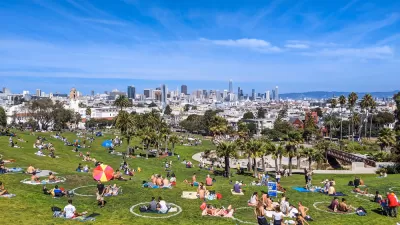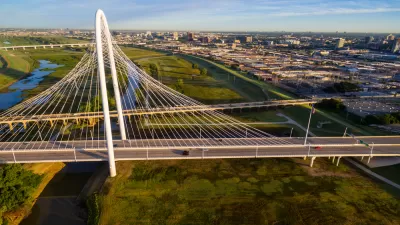The new urban public realm in the United States is highly programmed—some of that design approach reflects the trends of culture and some reflects a history of violence and bad for PR for parks at the end of the 20th century.

John King writes on the current trends in park design…actually, park programming. King's treatise begins with the example of Klyde Warren Park in Dallas.
Klyde Warren Park, constructed over a recessed stretch of the Woodall Rodgers Freeway, is a source of civic pride, a weekend magnet for residents from throughout the region, and a marketing hook used to lure residents to the glass condominium towers nearby. But in a broader sense, it is emblematic of the kind of public space favored by American cities at the moment—meticulously designed and programmed, city owned but privately funded and maintained, with an ever-changing array of carefully curated experiences. At Klyde Warren, you can play pétanque or croquet, laser tag or chess. You can practice your putting or take a ballroom dance class. No need to bring your own Jenga blocks; they can be checked out from the well-stocked Reading and Games Room. Public spaces such as this—picturesque destinations with plenty to offer and little left to chance—are made for the Instagram age. If they enrich public life in an era when the competition for resources is intense, they’re also oddly suited to an American culture in which the unknown is increasingly feared, and being aimless is the biggest sin of all.
Other, relatively recently designed and opened parks are compared for similarities—Millennium Park in Chicago, the High Line in New York City, Public Square in Cleveland, Crescent Park in New Orleans, Salesforce Park in San Francisco, Campus Martius Park in Detroit, Franklin Square in Philadelphia, and LeBauer Park in Greensboro, North Carolina.
Perhaps the most famous park of U.S. history offers a contrast. Frederick Law Olmsted and Calvert Vaux chose a decidedly different approach when designing Central Park in New York City, explains King:
When the pair designed New York’s Central Park, Olmsted sought to “completely shut out the city from our landscapes,” crafting refuges where people “may stroll for an hour, seeing, hearing, and feeling nothing of the bustle and jar of the streets, where they shall, in effect, find the city put far away from them.”
This long-read digs much deeper into the concepts and parks that best exemplify the tension between programmed park space and a more open approach. Regarding the latter approach, King identifies a term from sociology called "Loose Space" and also finds contemporary landscape architects who prefer a less programmed nature in parks.
King also helpfully notes that while the debate surrounding the tension between programming and nature gets attention in academia and from erudite designers, politicians are neglecting to pay much attention to these distinctions.
FULL STORY: At Play in the Fields of the Bored

Alabama: Trump Terminates Settlements for Black Communities Harmed By Raw Sewage
Trump deemed the landmark civil rights agreement “illegal DEI and environmental justice policy.”

Planetizen Federal Action Tracker
A weekly monitor of how Trump’s orders and actions are impacting planners and planning in America.

The 120 Year Old Tiny Home Villages That Sheltered San Francisco’s Earthquake Refugees
More than a century ago, San Francisco mobilized to house thousands of residents displaced by the 1906 earthquake. Could their strategy offer a model for the present?

In Both Crashes and Crime, Public Transportation is Far Safer than Driving
Contrary to popular assumptions, public transportation has far lower crash and crime rates than automobile travel. For safer communities, improve and encourage transit travel.

Report: Zoning Reforms Should Complement Nashville’s Ambitious Transit Plan
Without reform, restrictive zoning codes will limit the impact of the city’s planned transit expansion and could exclude some of the residents who depend on transit the most.

Judge Orders Release of Frozen IRA, IIJA Funding
The decision is a victory for environmental groups who charged that freezing funds for critical infrastructure and disaster response programs caused “real and irreparable harm” to communities.
Urban Design for Planners 1: Software Tools
This six-course series explores essential urban design concepts using open source software and equips planners with the tools they need to participate fully in the urban design process.
Planning for Universal Design
Learn the tools for implementing Universal Design in planning regulations.
Clanton & Associates, Inc.
Jessamine County Fiscal Court
Institute for Housing and Urban Development Studies (IHS)
City of Grandview
Harvard GSD Executive Education
Toledo-Lucas County Plan Commissions
Salt Lake City
NYU Wagner Graduate School of Public Service





























